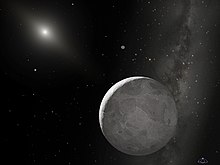ඩිස්නොමියා
(Dysnomia (moon) වෙතින් යළි-යොමු කරන ලදි)
ඩ්යිස්නොමියා එය නිල වශයෙන් හඳුන්වන්නේ (136199) ඊරිස් 1 ඩිස්නොමියා නමිනි. එය වාමන ග්රහලොවක් වන ඊරිස්ගේ චන්ද්රයෙක් වේ. එය 2005 දී මයික් බ්රවුන් හා ලේසර් කිරණ මගින් ක්රියාත්මක වන (Adaptive options) ගතික ප්රකාශ විද්යා පරීක්ෂණ කණ්ඩායමක් විසින් ඩබ්.එම්.කොක් නිරීක්ෂණාගාරයේ දී සොයාගන්නා ලදී. ඉන් පසුව එය S/2005(2003 UB313)1 වශයෙන් ඩයිසනොමියො ලෙස නම්කරන තුරු හඳුන්වන ලදී. (ග්රීක බසින් එහි අර්ථය නීති අඩුවීම (lawlessness)) ග්රීක ඊරිස් දෙවියන්ගේ දියණිය වූ ඩිස්නොමියා වෙනුවෙන් මෙය නම් කරන ලදී.
 Dysnomia, to the left, and Eris, center (Hubble Space Telescope) | |
| සොයාගැනීම | |
|---|---|
| සොයාගත් තැනැත්තේ | එම්.ඊ. බ්රවුන් (Michael E. Brown), එම්.ඒ. වෑන් ඩෑම් (M. A. van Dam), ඒ.එච්. බොවුකිස් (A. H. Bouchez), ඩී.ලි මිග්නන්ට් (D. Le Mignant), R. D. Campbell, J. C. Y. Chin, A. Conrad, S. K. Hartman, E. M. Johansson, R. E. Lafon, D. L. Rabinowitz, P. J. Stomski Jr., D. M. Summers, C. A. Trujillo, and P. L. Wizinowich[1] |
| සොයාගත් දිනය | 2005 සැප්තැම්බර් 10[1] |
| නිලනාමයන් | |
| MPC නිලනාමය | (136199) ඊරිස් 1 ඩිස්නොමියා |
| ශබ්දනැගීම | /dɪsˈnoʊmiə/ or /daɪsˈnoʊmiə/[a] |
| විකල්ප නම් | S/2005 (2003 UB313) 1 |
| විශේෂණය | Dysnomian |
| කක්ෂීය ලක්ෂණ [2] | |
| අඩ-මහා අක්ෂය | 37350±140 km |
| උත්කේන්ද්රියතාවය | < 0.013 |
| කක්ෂීය කාලාවර්තය | 15.774±0.002 d |
| ආනතිය | 142°±3° |
| මෙහි චන්ද්රිකාවකි | ඊරිස්ගේ |
| භෞතික ගුණාංග | |
| සමක අරය | 342±25 km (albedo five times lower than Eris's)[3] 175–245 km[4] 50–125 km[b][5] |
| දෘශ්ය විශාලත්වය | ~23.1[6] |
| නිරපේක්ෂ විශාලත්වය (H) | ~3.2[c][4][6] |

සටහන්
සංස්කරණය- ^ dis-NOH-mee-ə or dys-NOH-mee-ə. The first is the normal mythological pronunciation, the latter is used by Brown.
- ^ According to Michael E. Brown, it is 500 times fainter.
- ^ Dysnomia was found 4.43±0.05 mag fainter than Eris. With H = −1.19 for Eris, this gives H ≈ 3.2 for Dysnomia.
මූලාශ්ර
සංස්කරණය- ^ a b
Brown, M. E.; et al. (2006). "Satellites of the Largest Kuiper Belt Objects" (PDF). Astrophysical Journal Letters. 639 (1): L43. arXiv:astro-ph/0510029. Bibcode:2006ApJ...639L..43B. doi:10.1086/501524. සම්ප්රවේශය 2011-10-19.
{{cite journal}}: Invalid|ref=harv(help) - ^
Brown, M. E.; Schaller, E. L. (2007). "The Mass of Dwarf Planet Eris". Science. 316 (5831): 1585. Bibcode:2007Sci...316.1585B. doi:10.1126/science.1139415. PMID 17569855.
{{cite journal}}: Invalid|ref=harv(help) - ^ Santos-Sanz, P.; et al. (2012). ""TNOs are Cool": A Survey of the Transneptunian Region IV. Size/albedo characterization of 15 scattered disk and detached objects observed with Herschel Space Observatory-PACS". Astronomy & Astrophysics. 541: A92. arXiv:1202.1481. Bibcode:2012A&A...541A..92S. doi:10.1051/0004-6361/201118541.
- ^ a b Johnston, W. R. (30 December 2008). "(136199) Eris and Dysnomia". Johnston's Archive. සම්ප්රවේශය 2012-04-12.
- ^ Brown, M. E. (14 June 2007). "Dysnomia, the moon of Eris". Caltech. සම්ප්රවේශය 2011-07-03.
- ^ a b Green, D. W. E. (4 October 2005). "S/2005 (2003 UB313) 1". IAU Circular. 8610. සම්ප්රවේශය 12 January 2012.